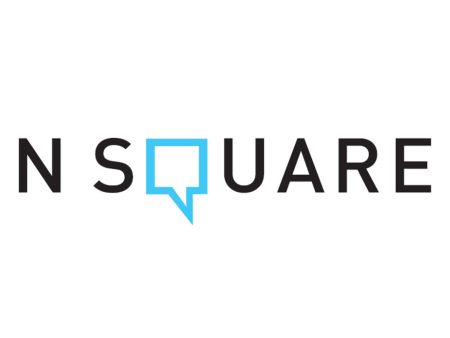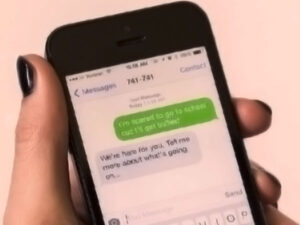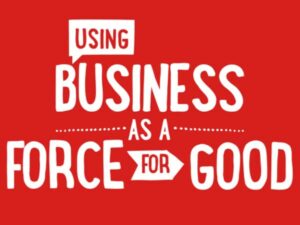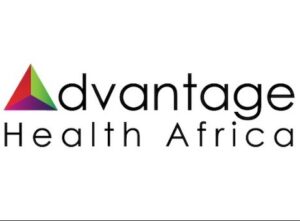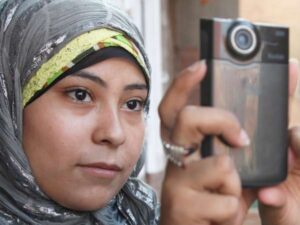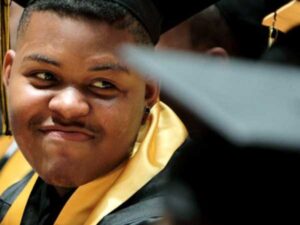N Square supports changemakers working on solutions that address the challenges of and reduce the risks associated with nuclear weapons. The organization recently forged a partnership and will operate under the name Horizon 2045 moving forward.
Erika Gregory of N Square / Horizon 2045 spoke with Jessica Kantor on December 4, 2023. Click here to read the full conversation with insights highlighted.
Jessica Kantor: Can you introduce yourself and also describe the problem that you’re addressing and how you’re responding to it?
Erika Gregory: I am Erika Gregory. I’m the managing director of a project called N Square. We’re actually merging with another project, also Skoll funded, called Horizon 2045, and we’ll be under that brand going forward. We started out by looking at ways to bring new people, insights, frameworks, solutions to the challenges of nuclear weapons, the abolition of nuclear weapons, and the reduction of risks associated with them. We spent the first 10 years of our work focused on that problem space. And with Horizon 2045, we’re expanding to look at the intersection between nuclear challenges and other challenges we face at the moment.
Jessica Kantor: Are you direct service?
Erika Gregory: We started out really as an intermediary. N Square, the first project started out as a funder collaborative. So the Skoll foundation, MacArthur Foundation, Hewlett, the Carnegie Corporation of New York, and the Ploughshares Fund all pooled resources. We really started out mostly re-granting, essentially scanning for signs of innovation and projects that might be harder for larger funders to get behind. And it evolved over time that one of the most important contributions we were making was to develop a really interesting global network of people who are problem solvers and leaders and innovators in all sorts of different areas. Early on, actually, after just the first couple of years, we began to focus on network and capacity building in the field. I would say it’s a mixture. We use grants as one tool, but we also do provide direct services to folks in this field, and we provide training and other forms of mentorship as well.
Jessica Kantor: This might be a multiple direction answer, but who benefits from your work and how do they benefit?
Erika Gregory: From the very beginning, we have used what we call a framework for success, which we’ve moved away from recently largely because the project itself is changing so much. But that framework was really the touchdown for years. The notion there is that our superordinate goal is eight or nine billion people on the planet would be our beneficiaries to no longer live under this sort of Damocles. But our more proximate beneficiaries are nuclear experts. And by that I mean people who run NGOs, academics, anybody working on nuclear challenges who is seeking to reinvigorate their practice or build networks, build a different epistemic community around this problem space.
I think that’s probably the most important thing to say, is that as an intermediary, we’ve been able to not only use dollars, but also our social capital to connect people who would never otherwise have found each other. The impact we have is supporting existing nuclear threat organizations to bring in new insights, new work with people from different disciplines they would normally find. So everything from artificial intelligence and data science to the arts. We have brokered these kinds of connections. It’s about finding and funding ways that incentivize innovation within that broader network.
Jessica Kantor: In regards to others that are now replicating what you guys do, what makes your approach distinctive? Or even just as an intermediary, what makes your approach distinctive?
Erika Gregory: Nobody does exactly what we do. Certainly in the nuclear space, we’re unique. I would say after a decade of doing this work that there are really interesting signs that existing institutions in this space, which we were never meant to be a long-term institution in this space, but have begun to embrace or institutionalize either some of our practices, tools, and techniques and even begin to hire some of the people that we’ve brought into this space. In that sense, I hope we’re becoming less unique, but nobody really does what we do.
I think what makes our approach distinctive is that we took the position from early on that there was no need for us to be experts in the subject matter because there are plenty of people who have dedicated their careers and are sort of building on almost 80 years now since we developed nuclear weapons, building on all of the knowledge that came before them. It was not important that our team be nuclear subject matter experts. It was important that we be really quick studies so we could be credible in conversations with nuclear experts. What made us different and unique, and it’s important I think to say that the reason our partnerships have worked is that we’re not the same as others. It’s like any good partnership, you find people who maybe you have values in common with, but you’re sufficiently different from each other that you each bring something to the potluck.
And in our case, it was that we have a tiny team, but we’d bring a cross-section of knowledge around strategic foresight. That’s everything from scenario planning to other forms of having a disciplined and rigorous way of thinking about the way the world is changing around us and what all those signs of change mean for the future so that we can be prepared for a range of different outcomes in the future. Strategic foresight is one piece of our bedrock that makes us different. The other is the innovation process, the creative process generally. All of us are quite experienced and I would say facile at building the conditions for people to do their very best and most unusual work. So there’s that piece around the creative process.
Then the third piece I would say is our attention to systems thinking. Really being able to get a top view of the system that we’re operating in and understand the kinds of levers that might be most useful to pull and to conduct, again, disciplined experiments around interventions and systems. I would say it’s systems thinking, innovation process, and strategic foresight that really have distinguished us. Then the last bit is that we pay a lot of attention to information design. We don’t see ourselves as wanting to fill the pipeline with more of business as usual in terms of white papers and so forth. But in fact, to take all of the findings that come out of the work we do with experts and bring those to life in ways that are digestible, accessible, and memorable by diverse audiences.
Jessica Kantor: Interesting. And how are you measuring success?
Erika Gregory: We actually did a quite in-depth review of our impact after the first eight or so years. And in that document we talk about, I mentioned before, the framework for success. What we said is there were two levels that we wanted to measure success on. The first was the degree to which we had an impact in this network we were building. And we knew that we would be successful if we could engage and maintain the engagement of innovators and influencers within a wide variety of spaces, in particular in technology and media. So journalism, yes, but also entertainment media. Also we wanted to be maintaining the engagement of leaders and emerging leaders within the nuclear field itself. So one measure of success was the degree to which both of those things were happening in balance with each other. Sort of outsiders coming into this space and staying engaged, and insiders working in new ways.
Jessica Kantor: How would you define engagement? For the journalists, would that have to result in coverage? And for the leaders, would it have to be them signing off for a partnership or what did that look like?
Erika Gregory: That’s a great question. Some of it is just quantifiable metrics. How many people engage with us, sign up for various newsletters, or have relatively passive involvement? And what does that growth curve look like over time? It’s also about measuring the impact of their contributions. As an example, let’s just take media for a second on the journalism side. We began investing in a relationship with a particular journalist named Lesley M. M. Blume. Lesley wrote a book called Fallout. It was about the journalism around the 1945 atomic bomb detonated in Japan. It was about John Hersey who was the journalist who covered all that. He was on the scene very, very quickly.
She told his story in her book, Fallout, and through that aperture began to be quite interested in nuclear issues. Over time, she would spend time with us in our network, and we had a series of cultivation conversations with Lesley about story ideas, because one thing that we’ve been able to observe is all of these super interesting human interest stories. We’re not journalists, but we are able to point people in interesting directions. Lesley, as a result of all of that, was placed in a couple of pieces with Nat Geo [National Geographic]. Those Nat Geo pieces were really interesting in particular because legislation right now, it’s under consideration. It’s called RECA, the Radiation Exposure Compensation Act.
The US government has over decades paid out billions, maybe at this point, trillions of dollars to people who were exposed to radiation because of where they live. For instance, in the American Southwest, in the downwind of the nuclear test sites, or even just people who live, for instance, the Navajo Nation, where the radiation is in their groundwater, it’s got into the water table. The problem is that, and so that’s been an interesting admission by the US government, that those activities were clearly toxic and also disproportionately harmful to people who are most marginalized in society.
However, it was limited, and there are tens of thousands of people who were not covered by the original RECA legislation. About a year or so ago, Lesley’s reporting actually was entered into the congressional record as having been instrumental in keeping this legislation alive for consideration. So we’re interested in the numbers, yes. We’re interested in the anecdotal evidence of people, journalists, for instance, being engaged with nuclear experts where they wouldn’t have been if we didn’t exist. We’re also really looking at stories of impact like that. And similarly, on the entertainment side, we did a lot of work for a number of years in Hollywood through a program called Hollywood Health and Society. In that case, we were mostly writing checks.
We were using grant money to support this work. But Hollywood Health and Society, which is part of USC’s Annenberg School, are themselves an intermediary with the entertainment community. They work with showrunners, producers, and writers rooms. And their job is essentially to bring experts into the writers room to ensure that storylines are as publicly minded and as accurate as possible. They had never supported storylines around nuclear issues until we came on the scene. Somewhere I’ve got all the reports about the number of television stories that were influenced by our coming into work with writers. In particular, Madam Secretary, did a couple of episodes, one of which was completely devoted to the possibility of a nuclear detonation and what would happen in the executive branch under those circumstances. I think we reached 12 million people that night that it aired, and then who knows how many other millions as a result of that show being still available. Those are the kinds of things we paid attention to, and that was media stuff that jumped to mind.
Jessica Kantor: That’s great. And that one with Lesley Blume, that’s a great example of your impact, but I just want to make sure that I understand the throughline. She worked with you all on her National Geographic articles to make sure that she had all of the proper information on nuclear impact, and then those articles were added to the congressional record as being a key part to keep RECA?
Erika Gregory: Yes. So the one amendment to that I would make is Lesley didn’t have access to the stories or the people that she ended up writing about. It was both our work with her to identify the kinds of stories that might be really worth telling, but also then to introduce her to the people whose stories she ended up telling.
There’s one woman in particular who’s an absolute hero in the Tularosa River Basin in New Mexico. Her name is Tina Cordova, and her story was the main event in the story that I’m talking about right now for Nat Geo.So it’s about this very personal matchmaking, idea generation support, cultivation.
Jessica Kantor: What are some insights or teachable lessons that can be taken from your work that others could use? What are some things that you tried that didn’t work?
Erika Gregory: I think that one of the barriers we face in anything, any big challenge space that’s worth paying attention to is the more we know, the less curious we become in a funny way. And so what we end up with is rooms full of people who are profoundly deeply knowledgeable within a narrow band, and in a way that knowledge gets more and more locked up and yes, less useful for the collective. Because unless you’re equally specialized and speaking that equally specialized language, you can’t really access that knowledge. Unless you happen to be reading the journal Arms Control Today, I mean, yeah, okay, maybe people in the nuclear field read that, but I’m pretty sure it’s not like bedtime reading for most people.
I think one of the big takeaways is that the really interesting work happens at the points of intersection between domains of knowledge. And what I think we’ve been quite good at, and it took us a little while to figure this out, is creating the conditions where you might be a climate person and the other person sitting next to you might be working on infectious disease, and then there’s a nuclear person sitting in the room. We’ve gotten quite good at creating the conditions in which those three people can have a really meaningful, deeply engaged conversation in which they all learn something.
Let me just give you a tiny little anecdote here. I talked to a funder not long ago who does not work on nuclear issues particularly, but is in an adjacent space. She said to me the least effective investment she ever made was in pulling a room full of people who think about peace building together with people who think about nuclear issues, nuclear weapons challenges. Now one would think that there’d be a whole lot of overlap there.
She said it was the least effective meeting she ever funded, in particular because the nuclear people could not stop talking to themselves. They just couldn’t make the crosswalk over to talk to people who are interested in creating conditions in which you would never need to threaten the use of a nuclear weapon.
To me, that says a lot about what I’m trying to say here. I actually think the unique contribution is creating the processes and culture and climate and incentives in which people genuinely rediscover curiosity and think about what’s possible in this creative abrasion space where things rub up against each other. And I actually think the potential of that is virtually unlimited. There’s a lot of interesting work and research that was done on this question of how do you reliably produce groundbreaking solutions in groups?
One of the things that had a big effect on me was that the research shows that you either want to have homogeneous groups who can talk to each other in that narrow band at a great level of depth, and they can just speak in their own unique language that they speak, and maybe they can get somewhere. So that can work. The other is you want a completely heterogeneous group, and if you fall somewhere in the middle of those two things, you have a problem because people begin to break down into factions if you have a little bit of diversity, but not enough diversity.
Our lesson in that has been, “well, we’ve got a field that spends all its time talking to itself, and they think that if they only had more money and they had a bigger megaphone, everybody would pay attention and would do what they know is best.” I think our team just fundamentally doesn’t believe that after 10 years. It’s actually about creating the conditions in which people show up differently, talk to each other differently, display some curiosity, and then somebody actually can hold that process successfully and get somewhere. A lot of this has to do with advanced levels of facilitation and process design. That’s a big takeaway for me over the last decade.
Jessica Kantor: Before you move on, I understand that there’s probably so many levels to this, but if you’re able to maybe share a couple of those key formulas for creating the perfect circumstances for both types of groups to collaborate successfully, that would be great.
Erika Gregory: I can tell you a little bit, it hasn’t happened yet, so I can’t promise you that it’s successful, but I can tell you about a pilot project we’re doing right now that puts all of this thinking to work. In this pilot, the origin was that people in the nuclear field were interested in thinking about the fact that we’re in a new nuclear arms race with Russia and China and thinking about the future of that. So the first step when you have an ill-formed problem like this, is spending 90% of your time on restating the problem or a well-formed problem statement. So we start by saying, “Well, we need to interrogate the question.”
Instead of focusing so narrowly on the question that’s going to get people to answer it in the way they always answer it, I have a colleague who says, “We may as well just hold up auction paddles and say, ‘You don’t even need to say your argument, you just flash number three and everybody knows what your argument is.’ Oh yeah, you always go to the same meetings and everybody always says the same things.” So the problem statement needs to solve for that. It needs to be open enough that you can get to the insights you’re looking for, let’s say about nuclear weapons, but you can get there in a way that harvests a whole lot more good stuff on the way. Instead we said, “No, let’s look at the future of what we’re calling the poly crisis.” So this meta crisis, lots of things happening at once. Let’s look at the question of what kinds of relationships on the world scene will become really important by the middle of this century in light of the fact that we’re going through this poly crisis.
From that question, you can still get to “what will the relationships with Russia and China be?” It’ll fall out of that question, but we won’t stay on that island in the process. We interrogate the opening question so that we have a “how might we question” that we can get to something that’s a much more open inquiry. And then from there, we find people who are at the top of their game in different issue spaces. And to be honest with you, we spend quite a bit of time with them one-on-one really making sure that they bring the personal or characterological qualities that you need to have for the conditions to be right.
The next step then is really finding people who have, yes expertise, but just as important as that, have the personal qualities and characteristics that we need. It’s like throwing a dinner party. If we’re going to work together for a number of months with people, we want them to be there because they’re as interested in learning something as they are in teaching something. They’re genuinely interested in expanding their horizons and that there feels like a reasonable ratio between what they can contribute and what they will get back. A kind of open mindedness and an ability to do lateral thinking. So we’re definitely looking for people who are able to say, “Oh, that thing you’re dealing with over there around malaria prevention on the African continent, that’s a systems problem actually that we see over here when we’re thinking about, I don’t know, governance of AIs.”
We need the people who are going to do that well. Then we feel like, “okay, we have the right problem statement, we have the right group of people.” And then it’s down to finding ways to create a level playing field for everybody. So in this process we’re designing now, we’re starting with an assumption that before we can even start thinking about the future out to the middle of this century, we have to understand we don’t all experience the present in the same way. We actually start by grounding the conversation in an examination of systems thinking. So we can say, if you’re thinking about systems that you operate in, you might be interested in the ways rules and norms are changing. What does that look like across all the issue spaces we’re talking about?
Now we’ve created a throughline that everybody can participate in. They’re all equally expert and inexpert on that topic. Then we jump into the future, which is absolutely a leveler because nobody here is more an expert on the future than anybody else. I don’t care what people say about predictive analytics or any of that. The fact is, thinking about the future is an intellectual exercise. It’s a thought experiment that gets us to just think a little bit outside of what we know is current reality. And once you get people into that kind of imaginative space, they apply their expertise in ways that are way more interesting and accessible to everybody else. It shows up in conversation rather than it being a lecture from the front of the room.
Jessica Kantor: It makes sense that putting this on in-person seems like it would be beneficial. Are you able to conduct these types of meetings virtually, or do you think that in order for it to be successful, it needs to be in person?
Erika Gregory: We are like everybody else, both forced into doing a lot of things remotely now, partly because we’ve gotten used to operating that way. But the other piece of it is, as a tiny NGO, it’s really hard for me not to pay attention to how much money we’re saving on travel, and also to be mindful about the carbon footprint of all of this convening that we do. So it feels like it’s incumbent upon us to figure this out. And yes, it’s really better to be in person a lot of the time, but we’re getting pretty good I think at figuring out how to use remote tools and to sprinkle them with experiences throughout, or even play with how long this kind of meeting should be, and when do we give people time to turn their camera off and just work independently for half an hour, then come back.
So we’re playing with different modes. We’ve certainly gotten, I think, quite expert in the use of spaces like Miro where we can begin to mirror back to people what’s happening in the conversation so they can see it. I think the next frontier for us is to figure out how we judiciously use face-to-face stuff. When is it absolutely critical to be face-to-face? And I don’t think we’ve cracked the code on that exactly, but I think that the future is something like ED 20 remote to in-person. I don’t think we’re going back to the way it used to be.
Jessica Kantor: For the different actors that you work with, are you mainly working with governments on their own? Are you working with intergovernmental organizations? Or are you working specifically with the United States government and then different NGOs throughout the world? Who are you working with mainly?
Erika Gregory: We don’t work specifically with governments per se. We mostly work with the international NGO community and transnational organizations. So for instance, in this pilot that I was just alluding to, we have people who are members of the Inter-Parliamentary Union, which is a giant organization or the European Leadership Network or the United Nations. We have a couple of agencies participating in the work we’re doing. The Elders are participating in this process and the intent there. Our theory of change, what we’re really proposing with Horizon 2045, is that when people ask how are our systems going to hold up in light of this weird confluence of threats we face, political systems, economic systems, we think we should be asking the opposite question, which is, “in light of all of this, how might we have an opportunity to reshape systems of human and planetary security?”
How do we actually get to reimagine and redefine what we mean by “global security”? Particularly at a time where we’re approaching the carrying capacity of this planet and we are coming up against all sorts of hugely problematic constraints. We think it’s time to completely re-envision what we mean, and the governance models that would support human planetary security. It’s an ambitious goal. Now, our hypothesis is that if we do that, there are some ideas and frameworks and weapons that will absolutely be anathema to that new definition, and they’ll begin to actually seem utterly irrelevant. And we believe that nuclear weapons are one of those things.
In order to get to that superordinate goal where we have a new framework for human planetary security and new governance models to support it, we think we have to be influencing decision makers and leaders in the short term who are going to be making decisions that have huge long tail consequences. Whether they’re thinking about modernizing nuclear arsenals or they’re thinking about legislation relating to AIs. So our theory here is that if we can have a world-class process for bringing influencers over those decisions together, so that they can go back into their networks and exert influence over decision making, that’s the most important work we could do over the next five years.
When I say we’re bringing this group of people together, it’s folks who will then be able to turn around. For instance, The Elders will be holding a meeting in I think June, where they will be seeking to influence sitting leaders of government W.e know there’s a forum for them to take the findings that come out of this process and immediately apply them.
We’re trying to get smarter about what all those international fora are, and what kinds of decisions are coming right around the corner, so that we can find the right people to be in the room with those leaders who typically think in extremely short-term time frames, as I think we all know. In all the interviews I’ve done recently,people have said leaders have zero understanding of the long-term consequences of the decisions they’re making now. So if there was one thing we could change, it would be for them to understand what they do today will influence a larger system of outcomes. That’s really where we’re trying to intervene.
Jessica Kantor: Which is so interesting because, and I know this is something that I think like Gen Z online has said multiple times in multiple ways, but it really is an issue that a lot of the people that are in office right now won’t be around in potentially 10, 20 years to even see some shorter-term impacts on the decisions that they’re making, which is so interesting.
Erika Gregory: It’s so interesting. And that’s why part of this project that we’re doing right now. We’re not only jumping into several different ways the future could unfold over the next 25 years, but we’re also using demographic trend data to bring to life the kinds of people who will be in positions of leadership in those futures. Because we know that in some ways, they’re going to be quite different from people who are sitting in leadership today. They’re growing up with a different value set, they’re thinking of themselves as citizens of the world in a way that was not true in my generation. We are trying to personify and make human as many of these ideas as possible so that people bring imaginative capacity to them in these conversations, not just intellectual capacity.
Jessica Kantor: What do you think is most needed from other actors or partners in order to advance systems level change?
Erika Gregory: I think in order to get traction around issues, we naturally segregate them. And certainly that’s true in philanthropy. We silo things and most foundations are set up to be as efficient as possible and to go as deep as possible in different issue spaces. But what we tend to lack is a reliable capacity to unleash all the latent knowledge and insight that is cross-cutting. We don’t have that.
I think this to me is one of the interesting problems of our time. To develop that greater capacity to do a meta level analysis and understanding of how these things all relate to each other so that we can find out if there are some common denominators. So imagine for a second that it’s like a pyramid. We have all of our program areas at the bottom of the pyramid. What I’m wondering is up here at the apex, is that the apex? Up here at the apex, what is the $64,000 insight that cuts across all those things? And it might be, for instance, around transnational governance or it might be around showing up in all of these issue spaces. Maybe that’s where the next $200 million needs to go. It’s the meaning making across domains where I think we need to do a better job collectively.
Jessica Kantor: How do you see your work evolving over the next five years? I know that you already shared where you hope to be in five years, but is the work itself evolving?
Erika Gregory: We’ve spent about four years in the Horizon 2045 project doing what I would describe as R&D. I think now it’s incumbent upon us to show that all of that investment has practical, applicable value. That’s why I mentioned we’re doing a pilot project, but I see us continuing to offer this kind of pragmatic process for people. It’s a way of bringing in everything we’ve built and learned. We’ve created some tools, which, if we had more time, I would show you, that are really interesting created with charitable dollars. We hope they get used broadly in ways of thinking about the future. I think part of our work is about making sure that all of this work has a chance to get adopted. That means I think we have to target some places where we think we can be helpful.
Philanthropy is actually an interesting target because so much is affected by sitting way upstream of NGOs, for instance, in the thinking that happens about how to invest in systems. I see our work being about making all of our R&D as pragmatically valuable as possible. I think that we’ll focus on working both with the philanthropy community and with the global security community, particularly as the UN, as an example, thinks about its hundredth anniversary. As we get to 2045, which is a big date for all sorts of reasons, I think that we want to be right in the middle of the conversation about what frameworks are we using to even define security in the world we actually live in now, not the world we lived in a hundred years ago. Who gets to be secure? What kinds of security? If you are in Vanuatu and you’re having to leave your island home because of sea level rise, what does human security mean to you? What does that have to do with weapons like nuclear weapons? Those kinds of things, I think, I see us being hoping to be in the center of those conversations.
Jessica Kantor: In terms of the audience for this interview, specifically journalists, social change entrepreneurs, academics who are learning from the model that you guys have created, is there anything else that we didn’t cover in this conversation that you think is really important to add?
Erika Gregory: I guess I would just come back to really a shout-out of appreciation for people out there who are pioneers in thinking about how to unlock the value of their own knowledge and how to have it be really in a commons. How do we have a commons in which all this knowledge that people have aggregated, like laying kindling for a fire, how do we actually light the fire to solve some of our biggest problems? So I just want to say I think that there are plenty of people out there who have the kind of curiosity and transdisciplinary orientation that we’re talking about now.
I personally believe that it’s that orientation along with a mental model about cooperation that are going to become the hallmarks of the next 25 or 30 years. Some people say the future is female. I actually think those are frankly feminist characteristics. So I might be one of those people who says it’s the way that we come together, it’s the way that we are with each other around these ideas and these knowledge bases that will matter maybe more than the knowledge itself.
Jessica Kantor: This has been such an interesting conversation. Thank you so much for connecting with me.
Click here to read the full conversation with insights highlighted.
Jessica Kantor is an independent journalist specializing in health, human rights, and social impact. Her work can be found in Fast Company, Healthcare Quarterly, The Las Vegas Review-Journal, and others. She is a living kidney donor.
* This interview has been edited and condensed.
Find other organizations working to decrease the threat of nuclear weapons.

